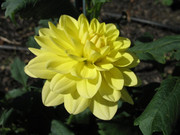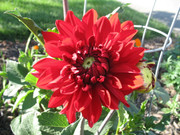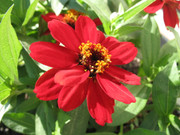Even with no rain (or, perhaps because of the increased sunlight and adequate water via irrigation), the gardens have taken off. While the Fourth of July is the traditional day for photos for the real start of summer, I took a bunch this evening.
A lot of the dahlia bulbs are second-year, so they're blooming much earlier. This Blue Boy normally wouldn't blossom until late July.

The same is true of the Sun Lady dahlia. These highlighter-yellow bloomers are some of my favorites!

The Babylon Red dahlia is new this year. Although supposedly a late-season bloomer, these are doing very well in late June. The flowers are pretty large and even redder than they look in these images.

The gene-mixed yellow/orange zinnia bred relatively true, so I'll be saving more of these for next year. They're a nice tangerine color.

The northwest face of the garden. It's a little spotty, and I just transplanted Melampodium and Easter Egg plant into the areas well, but the zinnia are starting to look nice.

This is one of the parent plants for that orange/yellow zinnia.

I really like the French Vanilla "white" marigolds. They were perfect last year, they're a hit again this year.

Monday, June 25, 2018
Late June Photos
Saturday, June 23, 2018
No Rain
We're getting rainfall in occasional drips and drops, but nothing appreciable. The grass is starting to go dormant, although I'm maintaining the gardens, of course.
You can water, about an inch a week total on most northern (and most southern, for that matter) lawns, done either all at once, once a week, or half the amount twice a week. Mow as long as you can tolerate the lawn to preserve water, and try to mow very early in the morning or just before sunset to minimize water lost to bleeding.
If you'd rather not water, that's fine for northern lawns, at least. Bluegrass will go dormant and incidental rainfall is usually more than enough to keep the roots alive. Rye and fescue will stop growing and are tolerant of weeks of little to no rain, although they have no dormancy mechanism as such. For southern lawns, Bermuda will go dormant and the mechanism is at least as good as bluegrass'.
If you see the dry spell coming, stop mowing. Even if the lawn is a little long, don't mow it. Longer grasses use less water, and shade their soil better, slowing evaporation of the water that remains.
Try to minimize the wear on the lawn during the drought. Normal usage isn't a problem, but a game of football might not be the best idea. Grasses that aren't quite fully dormant will take damage, as will fescue and rye that can't go fully dormant.
Don't feed. That's a good summer rule to begin with, but skip even the organics.
And other than that, don't worry too much. Grasses can tolerate a summer drought just fine and, worst-case, you may have to reseed in some places in very early fall.
Monday, June 11, 2018
Images Down
PostImage has had some problems lately and has changed their domain. As time wears on, I'll work a bit on restoring old posts--but not very hard or very much.
Things Are Really Underway...
I got distracted by any number of things and could either do the work or talk about the work. I did the work. :-)
The lawn's been fed (soybean, as always) as of May 1, and the gardens were planted shortly thereafter, once I was sure all chance of frost is past. Rain's been relatively consistent, with just a short June dry spell so far that had no real consequences.
The Babylon Red dahlia are doing extremely well. I hadn't expected them to blossom this early!

A new addition this year, the scarlet Profusion zinnia look like they're going to be incredible.
